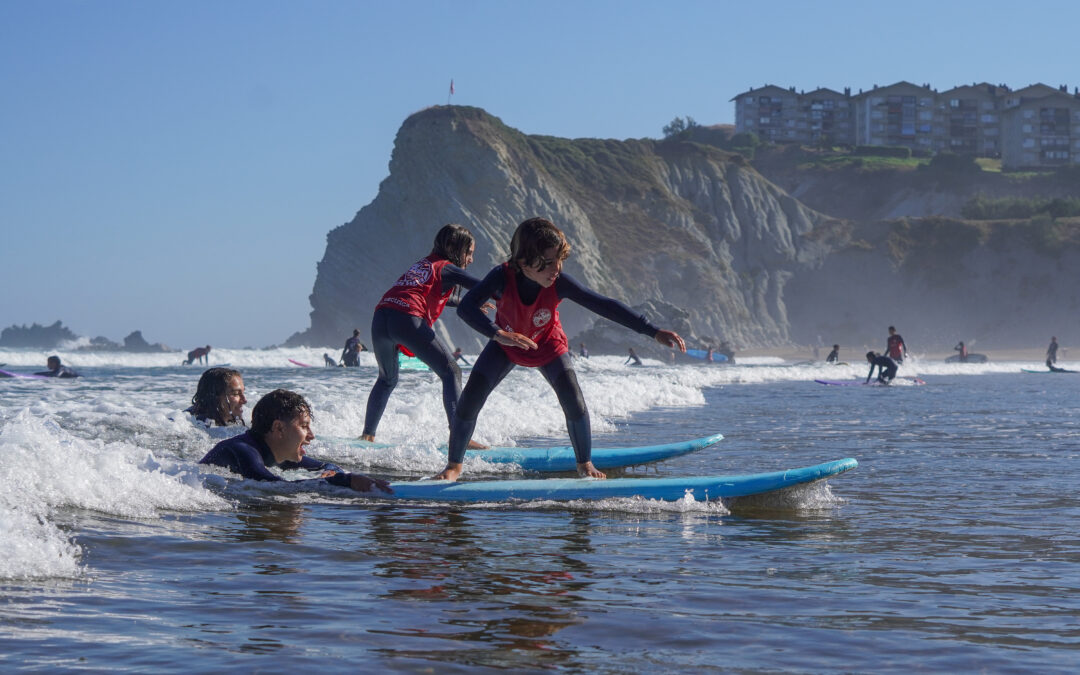At Peña Txuri Surf Eskola, we’ve spent years watching the youngest ones fall in love with surfing from their very first sessions. The mix of play, the sea, and personal achievement turns this experience into something unique and transformative for them. But we also know that teaching kids to surf requires more than just small boards and gentle waves: it demands patience, a pedagogical approach, and a lot of empathy.
Whether you’re a parent, an educator, or simply interested in introducing little ones to this world, here we share our experience and recommendations for teaching surfing in a safe, fun, and effective way.
Índice
At What Age Can Kids Start Surfing?
There’s no magic age to start, but in our experience:
- 🧒 From 2 to 4 years old: This is the time to play in the water, get familiar with the sea, and the waves. There’s no need to introduce a board yet; the goal is to build a positive relationship with the marine environment.
- 👧 From 5 to 7 years old: They can start working on coordination, balance, and playing games on the sand and in the water. Bodyboards are a great tool for them to glide and start “reading” the sea.
- 🏄 From 8 to 10 years old: They are ready to start with surfing itself. This is an ideal age to introduce them to structured lessons, with basic techniques and their first real waves.
Key Principles for Teaching Kids to Surf
1. Safety First
This may seem obvious, but we repeat it in every session: safety is non-negotiable. And we’re not just talking about soft-top boards and leashes. We’re talking about:
- Being in a controlled environment with suitable conditions.
- Using equipment appropriate for the child’s weight and skill level.
- Having attentive, trained instructors with a true passion for teaching.
At Peña Txuri, we always work in small groups with instructors specialized in working with children, and we adapt each lesson based on the sea, the group, and the day. The foundation of it all is a deep understanding of surf safety rules.
2. Never Force or Pressure
Some children jump in without fear, while others need their time. In both cases, our approach is the same: to support, motivate, and respect their pace.
🟦 If a child doesn’t want to get in the water, we don’t force them. We invite them, observe them, and give them space. Sometimes, just by watching others have fun, they end up joining in on their own.
3. Play as a Learning Tool
Teaching a child to surf isn’t about giving a technical lecture. It’s about playing with the waves, laughing when you fall, and turning the sea into a playground. That’s why in our kids’ classes, we use:
- Games on the sand to work on balance and strength.
- Group dynamics to build confidence.
- Imitation exercises to learn stances.
- Stories, challenges, and a lot of imagination.
When learning becomes fun, progress comes naturally.
4. Teach Them to Read the Sea from Day One
Believe it or not, children are great observers. From a young age, they can learn to read the waves:
- Where the waves are breaking.
- Which way is the channel to paddle out.
- How to know when a set is coming.
At Peña Txuri, they don’t just get on a board. We teach them to watch, to wait, to choose… all adapted to their age, but always encouraging autonomy and respect for the sea.
5. The Right Board for Each Stage
The wrong board can frustrate even the most enthusiastic child. That’s why we use different types of surfboards:
- Bodyboards for the little ones.
- Wide and stable soft-top boards for their first steps.
- Funboards or mini-mals only when they are ready.
And everything is always accompanied by properly-fitting wetsuits, colorful rash guards for visibility, and continuous supervision.
Where to Learn? Look for Specialized Schools
If you’re thinking of getting your kids started, we recommend choosing a professional environment like our surf camps for kids, where we combine learning, friendship, games, and safety.
Benefits of Surfing for Kids
Beyond the technical skills, surfing has a profound impact on children. You can read more about the benefits of surfing for kids on our blog.
- Improves balance and coordination.
- Boosts self-esteem and perseverance.
- Connects them with nature and promotes respect for the environment.
- Encourages sociability and teamwork.
- Reduces stress and hyperactivity through play and outdoor sports.
And most importantly: it teaches them to fall… and to get back up again. A lesson that is valuable both in and out of the water.
Teaching Kids to Surf is Teaching Them to Trust Themselves
It’s not just about standing on a board. It’s about looking at the sea without fear, believing in their own bodies, and enjoying every step of the process.
At Peña Txuri Surf Eskola, we believe that surfing is an incredible educational tool. That’s why we’ve spent years guiding the little ones on their first waves… and watching how, wave after wave, they become surfers with soul.
🌊 If you want your son or daughter to learn to surf, don’t just look for an activity; look for a positive and formative experience. We would be delighted to be a part of that journey.
See you at the beach, always with a smile and ready to play with the sea!

